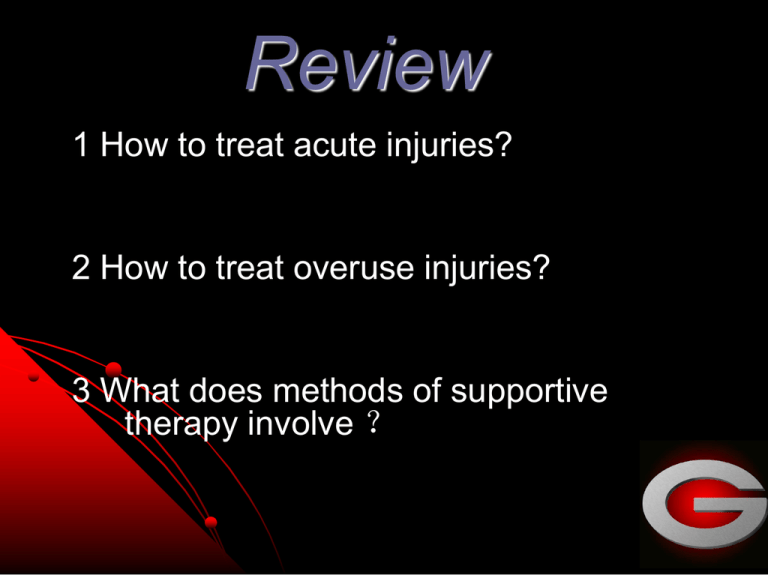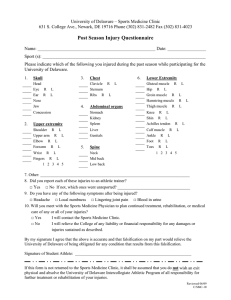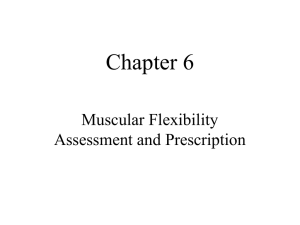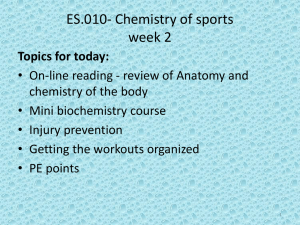Preventing Sports Injuries
advertisement

Review 1 How to treat acute injuries? 2 How to treat overuse injuries? 3 What does methods of supportive therapy involve ? Preventing Sports Injuries Treatment A. Warm-up and stretching Proper warm-up before all training and competition is a prerequisite for peak performance and for injury avoidance Warm-up • Precaution against unnecessary musculoskeletal injury and soreness • May enhance certain aspects of performance • Prepares body physiologically for physical work • Stimulates cardiorespiratory system, enhancing circulation and blood flow to muscles • Increases metabolic processes, core temperature, and muscle elasticity General – Activities which bring a general warming to the body(break a sweat) – Not related to sport Specific – Specific to sport – Stretching, jogging, running, throwing, catching Should last 10-15 minutes resulting in effects that will last 45 minutes Cool-down • • • • • Essential component of workout Bring body back to resting state 5-10 minutes in duration Often ignored Decreased muscle soreness following training if time used to stretch after workout Stretching Techniques Static stretching – Passively stretching – 6-8 second hold – Go to point of pain and back off and hold for 30 seconds (3 to 4 times) – Controlled, less chance of injury – Not dynamic B. Proper progression of training . One of the most important risk factors for overuse injuries is increasing the training load too rapidly C. Protective gear. Protective gear is one of the most well-documented injury prevention measures in sports. Helmet Fitting Trunk and Thorax Protection Ankle Braces Shin Guards Thigh Pads Elbow, Wrist and Hand Protection While the elbow is less commonly injured it is susceptible to instability, contusions, and muscle strain A variety of products are available to protect the elbow Wrist, hand and finger injuries are often trivialized but can be functionally disabling Susceptible to fracture, dislocation, ligament sprains and muscle strains Gloves and splints are available for protection and immobilization Dynamic Splints Used for injuries in hands and fingers Provides long duration tension on healing structures Combination of thermomoldable plastic, elastic and Velcro D. Fair play The playing rules and equipment for various sports have been modified to accommodate developing or disabled athletes. E. Physical exams. Routine preparticipation physical exams for healthy athletes cannot be generally recommended , as the costs are too high in comparison to the health benefits accrued.However, individuals with a known disease or injury should be examined to assess the potential risk and make the necessary adjustment in their training program. Common Sports Injury Rates (inj rates/1000hrs of activity) 1. 2. 3. 4. 5. 6. Rugby and Lacrosse (30) Basketball and Squash (14) Running and aerobic dance classes (11) Alpine Skiing (8) Rowing machine exercise (6) Treadmill walking or jogging (6) 7. 8. 9. 10. 11. 12. 13. Tennis (5) Resistance Training with machines (4) Resistance Training with free wts (4) Outdoor Cycling (3.5) Stationary cycle exercise (2) Stair climbing (2) Walking (2) How do you decide what to focus on? You need to understand the injuries in your sport and apply prevention and treatment strategies accordingly NCAA Injury Surveillance System Listed by Season Practice vs Game Injury Type by Body Part Balance Two Leg Squat Single Leg Squat Assessment The “CORE” of success Is involved in all activities. Controls motions between the upper and lower extremities. Protects the spine from extraneous motion. Lower Extremity Dynamic Stretching Be Sport Specific Shark Agility Test •Single leg multi directional hopping test •Count time and errors 1 2 3 4 Home 5 6 7 8











